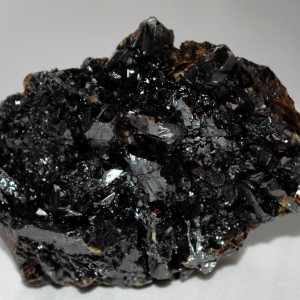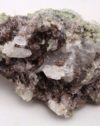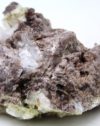HISTORY, NAME, LOCALITIES: Sphalerite, or zinc sulfide, has been known since antiquity and was recognized as a mineral species in 1824. Its name, pronounced SFAH-leh-rite, is derived from the Greek sphaleros, meaning “treacherous” or “deceitful,” alluding to its visual similarity to, and confusion with, the crystal forms of galena and other minerals. Important localities include Germany, Mexico, China, France, Spain, Peru, Australia, and the United States (Tennessee, Idaho, Colorado, Illinois, Kentucky, New Jersey, Missouri).
MINERALOGY, PROPERTIES, OCCURRENCE: Sphalerite [zinc sulfide, ZnS] crystallizes in the isometric system, usually as yellow or yellow-brown, octahedral or dodecahedral crystals. It has a Mohs hardness of 3.5-4.0, a subconchoidal fracture, perfect cleavage in six directions, a resinous-to-greasy luster, and a specific gravity of 3.9-4.1. Sphalerite is occasionally transparent, but is usually translucent to opaque with colors ranging from yellow and yellow-brown to reddish-brown, green, and near-black. It forms mainly in hydrothermal veins in association with galena and quartz.
METAPHYSICAL PROPERTIES, LORE, USES: Sphalerite is the primary ore of zinc and mined extensively worldwide. Transparent crystals are sometimes cut into distinctive collectors’ gems. Metaphysical practitioners believe that sphalerite balances the masculine and feminine aspects of personality, assists in changing vocations, and enhances introspection.
COLLECTORS’ INFORMATION: Sphalerite is collected both as individual and composite specimens, the latter in association with such minerals as galena, quartz, and calcite.





 Axinite #10
Axinite #10  Axinite #8
Axinite #8